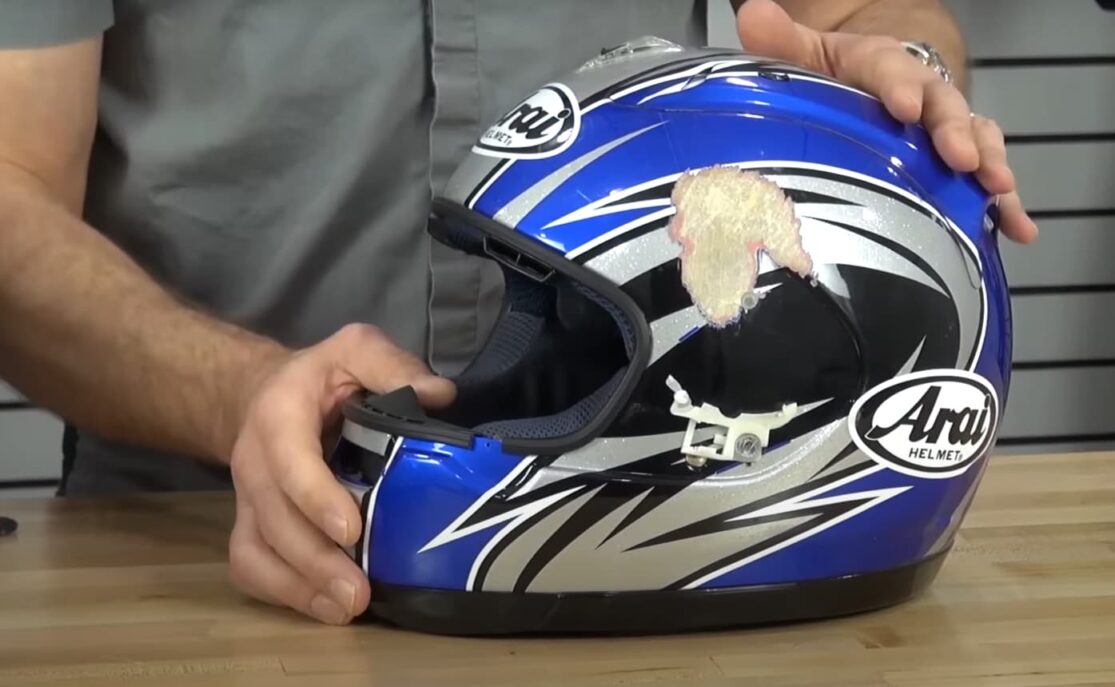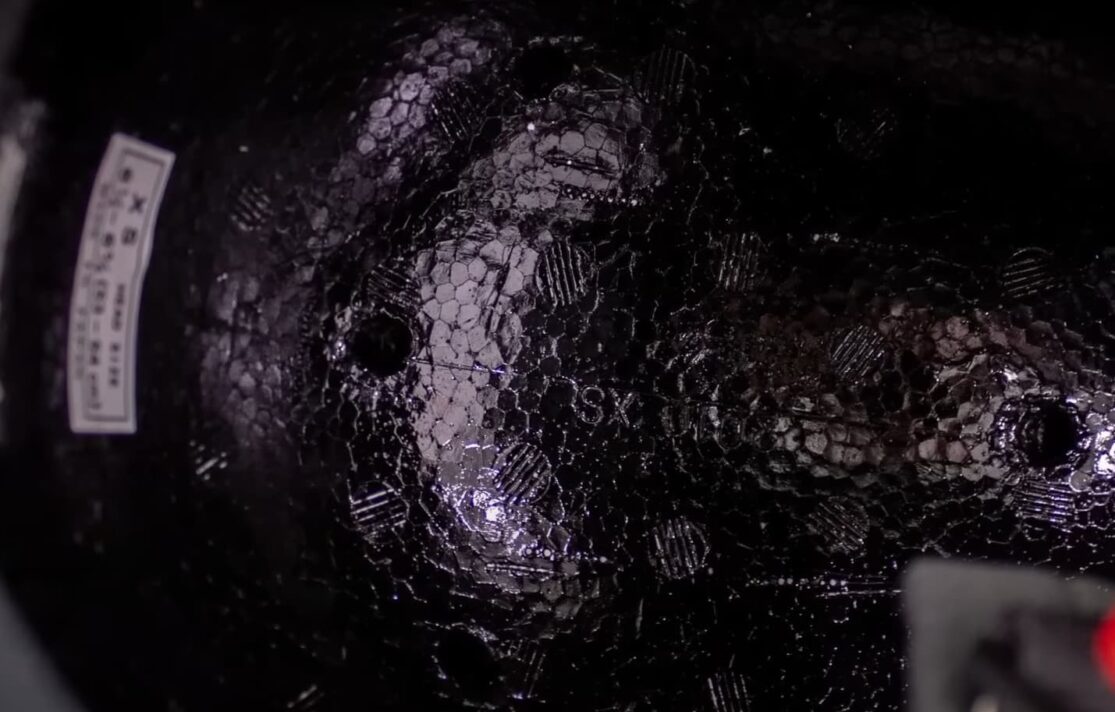The manufacturer of your helmet will, in most cases, recommend a replacement period of 3-5 years.
Exposure to solvents, chemicals, UV light, and accidents may all contribute to the loss of your helmet’s reputation. If the outer shell or inner foam liner of your helmet has faded coloration or displays cracks on its surface, it might be time for a replacement.
The majority of helmet linings are made of foam polystyrene and are intended to be used only once. If your helmet sustains an impact, you should consider replacing it. This is because the inner portion of the helmet may no longer be as safe as it once was. If you’re looking for a new helmet, check out the options for the best modular motorcycle helmets on the market.
Your bike helmet’s performance can be jeopardized in a variety of ways. The most crucial thing is to be able to tell whether the damage is severe enough that it has rendered your helmet useless.
A bike helmet is a type of helmet worn while riding a bicycle. It helps protect the cyclist’s head in the event of a crash or fall. Bike helmets are required by law in some jurisdictions. They are also recommended for recreational cyclists. In this blog post, we will answer the question: how long does a bike helmet last?
Do Bike Helmets Have An Expiration Date?
The average bicycle helmet does not have an expiration date, technically speaking. This implies that you’ll need to examine several variables as well as inspect the helmet to see whether it needs to be replaced.
Depending on the manufacturer, some experts advise changing your helmet every three years, while others advocate replacing it after 5-8 years. In general, the differences seem to be dependent on the manufacturer’s quality of construction and materials utilized. While many helmets appear identical, there can be variations between them; if you’re able, consult a professional.
The manufacturer’s expiration date is not a gauge of how long your helmet should last. However, it does not imply that after the stated period has elapsed, your helmet will automatically be useless. The necessity for renewal might arise sooner or later depending on various circumstances. For more information on motorcycle safety and gear, visit MotorradProfy website.
It all comes down to the amount of attention you give your helmet. Aside from serious impact, there are a variety of factors that can reduce the effectiveness of your helmet, including chemicals and solvents (glues from stickers), as well as external exposure to UV rays. All of these can cause the helmet materials to degrade over time, making it less effective at doing its job.
It’s important to keep an eye on your helmet so that you can replace it when necessary. Check for cracks, dents, or other signs of wear and tear; if you see any, it’s time for a new one. Also, be sure to clean and store your helmet properly to extend its lifespan as much as possible.
With proper care and attention, your bike helmet can last for many years – but don’t forget that it needs to be replaced eventually. Paying close attention to both your helmet and how you use it is the best way to ensure that you stay safe while cycling.
Check for any dents or cracks on the outer shell, and then softly poke it to see if it bounces back into its original position.
Another thing to look for is any tears in the foam lining or cracks in the strap or buckles. This will provide you with a hint that it’s time to replace your helmet for your protection.

Why Replace Bike Helmets Regularly?
The goal of a bike helmet is to prevent your head from suffering an injury. According to helmet safety data, incorporating a bicycle helmet can reduce the chance of brain damage by up to 70%. As a result, cyclists require a bike helmet.
It is critical to replace bike helmets regularly to ensure that they continue to perform well when riding. If you wear your bike helmet often, it will get damaged by the sun and moisture. As a consequence, it gradually degrades its ability to safeguard you in the event of an accident as a result.
Additionally, certain parts of the country are more corrosive than others. If you live near the ocean, for example, salt air can degrade a bike helmet more quickly. As such, it is important to inspect your bike helmet regularly and replace it sooner if there are any signs of wear and tear.
Your bike helmet is exposed to solvents, chemicals, UV light, fluids, and other substances when you excessively use it. These environmental factors may have a significant influence on the gear’s performance. It can’t handle pressure or big collisions.
The inner foam liner inside the equipment, which protects you against collision or clash, might wear down over time. The protective foam’s ability to soften and absorb a blow from a collision or bang will be significantly reduced. As a result, it won’t work as well when needed.
Finally, keep in mind that children’s helmets need to be replaced more frequently than adult helmets since they outgrow them quickly. Additionally, their skulls are still developing and thus require more protection from injuries.
How Often To Replace Your Helmet?
Bike helmets are designed to protect your head during a fall. However, they have a limited lifespan and will slowly degrade over time. The United States Consumer Product Safety Commission (CPSC) recommends replacing your bike helmet every 5 years.
However, this is just a general guideline and you may need to replace your helmet sooner depending on how often you ride and the conditions you ride in.
If you are unsure if your helmet needs to be replaced, look for signs of wear and tear such as cracks in the shell or worn-down padding. Also, check the expiration date that should be listed on the inside of most helmets. If it has been more than five years since the helmet was manufactured, it is probably time for a new one.
While replacing your bike helmet every few years may seem like a hassle, it is important to do so to ensure that you are properly protected while riding. A new helmet will provide better protection than one that is old and damaged.
So, how often should you replace your bike helmet? The general guideline is every five years, but depending on how often you ride and the conditions you ride in, you may need to replace it sooner. Be sure to check for signs of wear and tear and always check the expiration date before heading out on your next ride.

When Should You Immediately Replace Bike Helmets
After Getting A Crash
If you were unfortunate enough to crash while wearing your helmet, then it’s time for a new one. Even if the helmet looks fine on the outside, the inside could be damaged.
It’s always better to err on the side of caution when it comes to your safety, so replace your helmet after any kind of crash.
Most cyclists are well aware that bicycle helmets should be replaced following a head collision. Academics and non-profit organizations agree. The helmet’s foam portion has been created to withstand only one hit. You may not be able to tell whether the helmet is damaged based on its appearance.
Be thankful that the helmet performed its function. In some cases, the protection of the helmet may not even persuade a rider to believe they had struck their head. The accident might not happen on a bike ride. A hard surface striking the helmet can have long-term consequences.
After Dropping It Hard On A Surface
If you drop your helmet on the ground or a hard surface, it could potentially damage the helmet’s structure. Even if there are no visible signs of damage, it’s better to replace your helmet to be safe.
Again, safety should always be your number one priority when riding a bike. So make sure to replace your helmet every few years and after any accidents.
How To Choose a New Helmet
Safety Standards Come First
The most important reason to wear a helmet is protection. You should shop for a helmet that will adequately protect you in all sorts of cycling activities. Always look for a label that certifies that the helmet meets necessary safety criteria.
A multi-directional impact protection system is available on some helmets. This means it can lessen the rotational force and energy that is directed to the head in the event of a collision or accident. As a consequence, the force with which your head is hit as a result of an accident is significantly reduced.
Other brands, such as Bell, offer further protection through progressive layering. To deal with various degrees of impact and energy during a collision or incident, these helmets have two separate layers of EPS foam in varying densities. You may also discover helmets with a tool-free detachable chin bar that converts from a helmet into full-face safety.
Helmets with several vents and bright color schemes may improve safety. The number of vents on a helmet aids in the circulation or ventilation of air on your head. Vents allow for decreased contact between your helmet and head, which can assist decrease the amount of energy or force that is transferred to your head in a severe accident or blow.
Bike helmets that are brightly colored, on the other hand, may help you be seen while driving. It lowers your risk of being struck by another motorist.
Size
There are three basic helmet sizes: small, medium, and large. To find out your size, wrap a measuring tape around your head just above your eyebrows. If you fall between sizes, choose the smaller size for a snug fit or the larger size for a looser fit.
Most helmets come with an adjustable sizing dial on the back that lets you tighten or loosen the helmet as needed. Once you have adjusted the helmet to fit snugly, put on a pair of goggles or sunglasses to make sure they don’t throw off the fit. You should be able to look up and see the top of your glasses’ frames clearly when they’re in place.

Material And Components
Bike helmets are made from a variety of materials. The most common material is polystyrene foam, which is used in about 80% of bicycle helmets.
Other materials include expanded polypropylene (EPP), extruded polystyrene (EPS), and urethane. EPS is the type of foam typically used in “skateboard” helmets.
The outer shell of the helmet is usually made from one or more types of plastic, such as acrylonitrile butadiene styrene (ABS), polycarbonate (PC), or fiberglass. The helmet straps are usually made from nylon webbing.
The padding inside the helmet is also important for comfort and fit. Most helmets have about a millimeter of padding. Some helmets have more padding in the front and back, and some have extra padding on the sides.
The type of helmet you need depends on how you will be using it. For example, if you are an avid road cyclist, you will need a different helmet than someone who only uses their bike for commuting.
There are 3 main types of bicycle helmets:
- Road helmets are designed to be lightweight and aerodynamic;
- Mountain bike helmets are designed to protect your head from impact while also providing ventilation;
- Multi-use/commuter helmets are a combination of the two and can be used for both road and mountain biking;
Reliable Manufacturer
There are many manufacturers of bike helmets. However, not all manufacturers are created equal. When choosing a bike helmet, it is important to choose one from a reliable manufacturer. A good way to tell if a manufacturer is reliable is to look at the warranty they offer on their products. A manufacturer that offers a long warranty is usually confident in the quality of its products.
If you choose a bike helmet from a reliable manufacturer, you can be sure that it will last for many years. Most well-made bike helmets will last for several years, even with heavy use.
Proper Care and Maintenance
Bike helmets, like any other piece of sporting equipment, need to be properly cared for if they are going to last. This means storing them in a cool, dry place when not in use and making sure they are clean before each use. It is also important to check the helmet regularly for any signs of wear or damage. If a helmet is damaged, it needs to be replaced immediately.

FAQ
How long are kids’ bike helmets good for?
The normal lifespan of a kid’s bike helmet is 3-5 years. The helmet’s continual usage and minor knocks cause it to wear down over time. It’s illogical to think of keeping your youngster in the same helmet for years unless the size is correct and the appearance is acceptable on the surface.
Should I buy a used bike helmet?
If you’re considering purchasing a used helmet, it’s important to inspect it for signs of wear and tear. Look for cracks in the shell or liner, as well as any looseness in the fit. A used helmet may not offer the same level of protection as a new one, so it’s important to make sure it isn’t damaged. If you have any doubts about its condition, it’s best to err on the side of caution and choose a different helmet.
Another thing to keep in mind is that helmets have a limited lifespan. Even if you don’t see any damage, the materials may degrade over time. Most manufacturers recommend replacing your helmet every five years or so. So, if you’re using a used helmet that’s more than a few years old, it’s time to start shopping for a new one.
Do bike helmets have a shelf life?
A bike helmet has no expiration date, but it should be replaced every 5 years.
Do more expensive bike helmets protect better?
The answer to this question is a little more complicated than a simple yes or no. In general, yes, more expensive bike helmets do offer better protection. But it’s important to keep in mind that the price of a helmet is not always indicative of its quality. There are plenty of high-quality, affordable helmets on the market. And some very expensive helmets don’t provide as much protection as you might expect.
Where is the manufacture date on a helmet?
The hard hat’s date of manufacture is usually printed on the underside, usually beneath the brim. Take a peek at the inside of your hard hat if you turn it upside down. The year of manufacture is written in the center, with an arrow indicating the month.